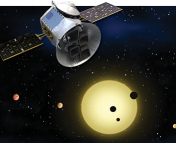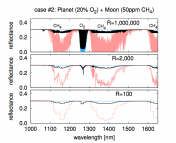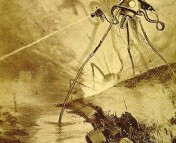Title: Which stars can see Earth as a transiting exoplanet?
Authors: L. Kaltenegger, J. Pepper
First author’s institution: Carl Sagan Institute / Astronomy Department, Cornell University, Ithaca, NY, USA
Status: Available on arXiv (open access)
As of today, October 31st, 2020, scientists have already discovered 4,296 worlds around other stars. The transit method (particularly with NASA’s Kepler satellite) is responsible for 3,240 (a whopping 76.1%) of these discoveries. So much research has gone into finding stars that host transiting planets—but which of these systems would have a vantage point to see Earth transit the Sun?
Not all exoplanets would be able to see Earth transit. Transits depend on viewing angle; that is, a planet has to be lined up with its star for us to see it pass in front of the star (as in Figure 1). Calculations of this angle determine the “Earth Transit Zone” or ETZ, a thin strip of the sky around the ecliptic (only half a degree wide, the same width as a full moon!) where observers could see Earth transit. The restricted Earth Transit Zone (rETZ) is a subset of the ETZ where observers would see Earth transit for more than 10 hours (equivalent to an impact parameter b<0.5, see figure 1 caption), which is only ⅕ of a degree wide.
Why do we care about what planets can see us? Well, anyone observing us at any point in the last two billion years could have detected biosignatures (chemical signs of life, like oxygen, ozone, and methane) in our atmosphere, just like we’re trying to do with future telescopes like JWST and LUVOIR. If we make a list of stars that can observe transits of Earth, then we have a place to start our searches for extraterrestrial intelligence, like Breakthrough Listen, which listen for technological signals from other planets.
Previous research has made versions of this target list, identifying exoplanets that can observe the transiting Earth. Using data from Hipparcos, a spacecraft that measured parallaxes for a large number of objects, one group observed 82 stars within 1000 parsecs in the rETZ. They extrapolated from their observations to estimate that there should be more than 500 stars in the rETZ. Another group used the SIMBAD catalog of stellar data to identify 1,022 G and K stars in the ETZ. The problem with these older studies is that they were limited by the data sets they were using, which were incomplete or included stars with poorly measured properties.
Today’s paper improves on past efforts by using the TESS Input Catalog (TIC) and Candidate Target List (CTL), as well as data from Gaia’s second data release (DR2). TESS’s CTL is particularly useful since it focuses on main sequence stars, usually preferred for exoplanet surveys and searches for life. Gaia provides extremely high precision new measurements of stellar distance and motion, which is especially important for dwarf stars. The authors decided to use data from both sources, and exclude evolved stars and stars with poorly measured parameters. This does mean their list of stars might miss some late-type stars or high proper-motion stars, but those aren’t the primary targets for planet searches anyways. Interestingly, some high proper motion stars will move into the ETZ in our lifetimes, like Teergarden’s star (which does host a confirmed planet!) in 2044.
The authors’ list of main sequence stars with quality data contained a whopping 10.3 million stars in the ETZ. They narrowed this down to select stars in the ETZ and rETZ that are closer than 100 parsecs from Earth. This found 1,004 stars within 100 parsecs that could see a transit of Earth, and 508 stars that guarantee 10 hours of observing time. Most of these are M stars, the small, red, long lived dwarfs at the end of the Main Sequence (see Figure 2).
In this list of stars, two of them are already known to have planets! K2-155 has three planets (including one possibly newsworthy super-Earth), and K2-240 has two (also including a super-Earth!). Scientists are still unsure on what fraction of stars have Earth-size planets in the habitable zone, but estimates range from 10-50%. Even if the lowest estimate is right (10%), that would mean 100 of these planets in the ETZ!
To make sure this list is complete, the authors recommend a complete census of nearby stars (closer than 100 parsecs), and studies that come up with better age estimates for all these stars. Stellar ages are often hard to determine, but they can help us determine if a planet there would have had time to evolve life (and thus be a worthy SETI target!). TESS is also going to look for transiting planets in the ETZ during its extended mission, so we can find out if there are more planets that could have observers looking at us! Thinking about our neighboring stars and their planets can help us refine where to look for life, and today’s paper was a step towards making a list for that.
Astrobite edited by: Sumeet Kulkarni
Featured image credit: NASA




